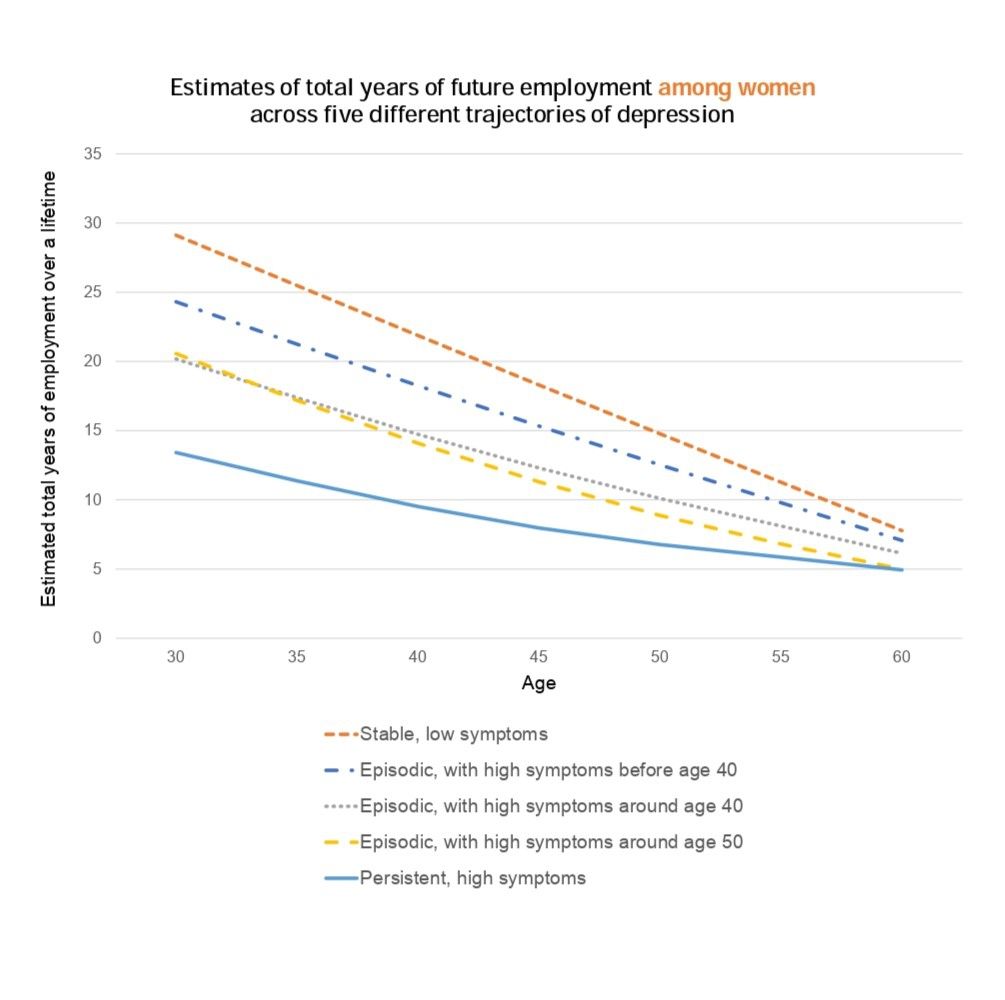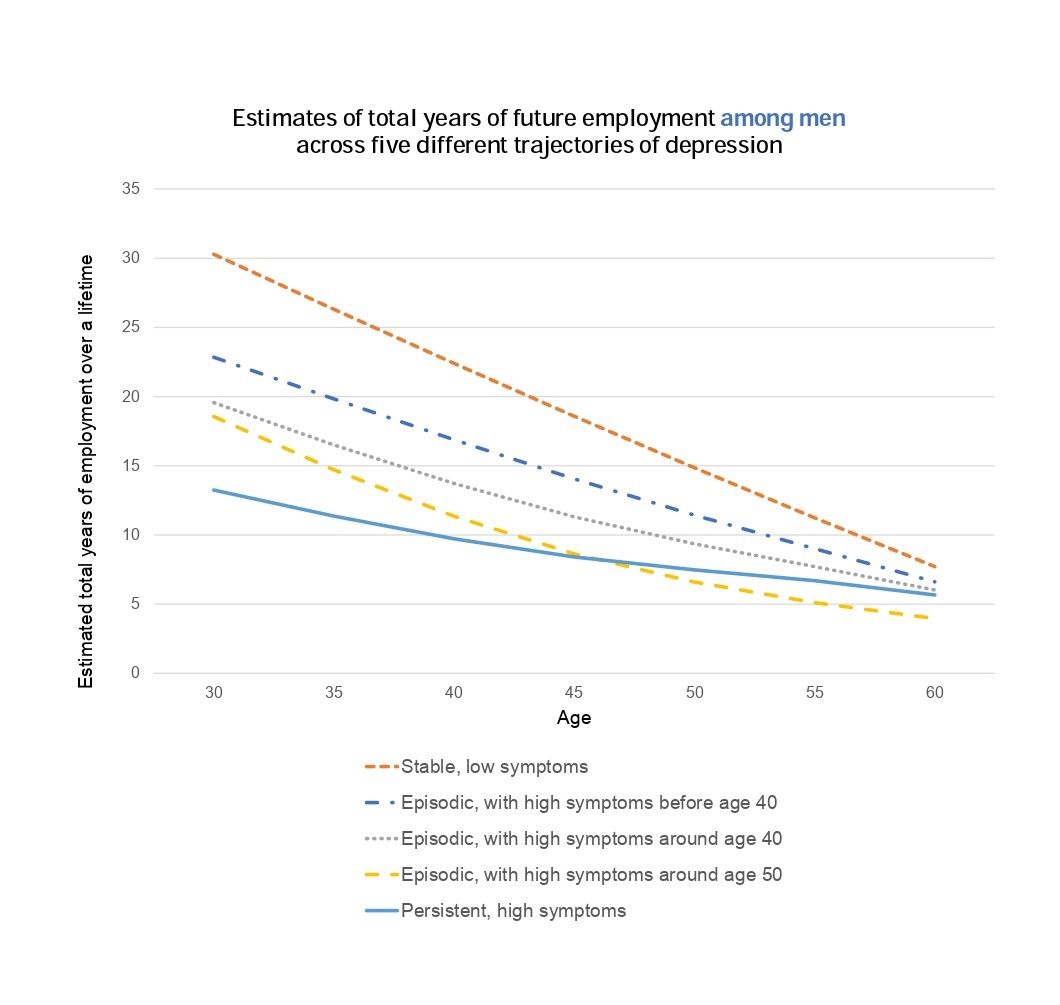If someone experiences depression, what is the impact on the length of their future working life?
That was the question asked by the team of Institute for Work & Health (IWH) scientists on a recent study, now published in Social Psychiatry & Psychiatric Epidemiology.
The answer? It depends on how, and when, someone experiences depression. The study found, in a sample of working-aged adults, five patterns along which symptoms of depression may appear over a person’s working life, each with differences in working life expectancies (WLE). WLE is measured as the total years of future employment an individual is expected to experience at a given age.
According to U.S. Census data, an estimated 6.6 per cent of American adults experienced symptoms of depression in 2019. Despite advances in depression treatment methods, individuals with depression tend to have lower likelihoods of stable employment and career progression, and increased risk of unemployment and early exit from the labour force. In this study, IWH researchers aimed to provide a more thorough understanding of how depression can affect individuals’ working lives.
Existing studies of depression and work life expectancy typically base their findings on depression symptoms measured at one time point, but people's lives ebb and flow, and depression and work status can change throughout someone’s life,
says Dr. Kathleen Dobson, IWH associate scientist and study lead. With a better understanding of the course of depressive symptoms over an individual’s lifetime, research may better inform welfare, health and social service programs and policies aimed at assisting individuals with depression.
The sample
In this study, available free of charge (doi:10.1007/s00127-023-02547-4), Dobson used a sample of 9,206 participants from the U.S. National Longitudinal Survey of Youth 1979 cohort, which, since 1979, has been collecting information annually or biannually from 12,686 Americans born between 1957 and 1964. (The cohort was created when participants were between the ages of 14 and 21.) Participants were asked, among other measures, about current employment status and employment history, as well as whether they had experienced any symptoms of depression. The sample in Dobson’s study included those with at least one measurement of depressive symptoms over the study period.
Five patterns of depressive symptoms over adulthood
Drawing on the wealth of data from this survey, the team mapped symptoms of depression over four time points including 1992, 1994, when a participant turned 40, and when a participant turned 50. (Participants turned 40 between 1997 and 2004, and 50 between 2007 and 2014.) The team then aimed to identify different patterns or trajectories of depression over several years of a person’s working life, as well as the WLE associated with each trajectory. The study also investigated how WLE in the various patterns of depression differed by race/ethnicity and education level.
To estimate WLE, Dobson’s team used the study data to document the actual changes in employment status for each participant. Drawing on monthly data collected over a 30-year period, the team built a model that mapped the sequence of changes through the labour market—for example, whether a participant went from being out of the labour force to employed then back to unemployment, etc.—for each participant. Using that model, the team then applied simulation modeling techniques to estimate the WLE or the total number of years of employment an individual will experience for each depression symptom trajectory group.
Five depression symptom trajectories were identified from the sample. Each of which showed differences in WLE. The WLE reported for each trajectory in the table below estimates how many years of employment a person will experience in adulthood starting at age 30 for men in the sample. Estimates for women were similar. The graphs depict the data shown in the table.
| Men | Women | |
| Description of trajectory (number of participants; per cent of the sample) |
Estimated number of future years of employment at age 30 | Estimated number of future years of employment at age 30 |
| Stable, low depression symptoms (6,838 participants; 74 per cent) |
30.3 years | 29.1 years |
| Episodic, with high depression symptoms occurring before age 40 (995 participants; 11 per cent) |
22.8 years | 24.3 years |
| Episodic, with high depression symptoms occurring around age 40 (526 participants; 6 per cent) |
19.6 years | 20.2 years |
| Episodic, with high depression symptoms occurring around age 50 (570 participants; 6 per cent) |
18.6 years | 20.6 years |
| Persistent, high depression symptoms (277 participants; 3 per cent) |
13.2 years | 13.4 years |


From these findings, it’s clear that not everyone who experiences depression in adulthood has the same experience in the labour force,
says Dobson.
The majority of the study sample had a stable pattern of low symptoms from the late 20s to the early 50s. “A reader can think about this group as likely not experiencing clinical levels of depression,” says Dobson. The remaining 26 per cent of individuals in this sample experienced high levels of depressive symptoms at some point between their late 20s and early 50s. Those with persistently high symptoms (three per cent of the sample) had the lowest WLE of the sample between ages 30 to 55, indicating the impact of persistent depression on a person’s working life, and the potential benefits from enhanced supports for people experiencing depression.
Around age 30 is when adults enter their prime working years,
says Dobson. From our simulation models, we saw that at age 30, those in the low depression symptom group were expected to remain employed, on average, until age 60. For those with persistent depressive symptoms, they experienced 13 years of employment until age 60. That’s a 17-year difference in the future working life at age 30, which can have a profound impact on people’s lives.
Most participants who reported high levels of depression, however, experienced them episodically rather than persistently throughout their adult life. Individuals who experienced episodes around age 40 or 50 also (approximately 12 per cent of the sample) had a lower WLE than those with persistently low symptoms. Participants in all three episodic depression trajectories also spent a greater proportion of time out of work and had more frequent job changes than the low symptom trajectory participants.
These findings highlight the impact that even occasional bouts of depression can have on someone’s working life,
says Dobson. A takeaway from these results is the importance of practices within workplaces and the broader healthcare system aimed at providing support to individuals to prevent depressive episodes from happening in the first place or, if that’s not possible, to find ways to mitigate the effects of depression on their working lives, she notes.
We know that for many people who have experienced episodes of depression, once they move into remission, on many work and health outcomes, they generally start to look more like someone who has never experienced depression,
says Dobson.In addition to supports sought by an individual, continued support by employers, workplaces, and disability insurance systems could help keep individuals who experience depression could help to keep these individuals in the workforce for longer, more stable periods.
Effects of race/ethnicity and education level
The research team also examined WLE estimates among depression trajectories incorporating participant’s race/ethnicity, and education level. Results suggested that these factors did impact WLE among those with depression. In particular, lower WLE was seen among Black men who experienced any depression trajectory, and among those with less than a high school education.
Our study highlights clear differences related to race and ethnicity and to education level that persist in WLE,
Dobson says. In terms of education level, some research suggests that individuals with lower levels of education in emerging adulthood may be at a higher risk of both depression and unemployment, while higher levels of education during this time, along with more resulting job security, may act as a buffer from future depressive episodes.
Race and ethnicity were also seen to be important factors influencing WLE estimates, with higher proportions of Black and Hispanic individuals in the episodic or persistent, high symptom trajectories than in the persistent, low symptom trajectory. Racial discrimination at a structural level is understood to have led to longstanding labour inequalities, as well as differences in health-care access and behaviour, which represent possible pathways that may be influencing these findings. For example, some research suggests that due to stigma, fear of social and health ramifications or limited availability of culturally appropriate mental health professionals and treatment options, members of Hispanic or Black communities may access mental health services later or less frequently than white communities.
The findings of educational and racial impacts on WLE among those with depression suggest the need to focus not only on workers with depression–and getting them clinical treatment as well as access to education and health resources–but also the need to address systemic barriers that impact significant numbers of Americans,
says Dobson.
The findings of this study point to areas where employers, labour organizations, policy-makers and health professionals could focus. They can consider practices and policies to improve support for adults experiencing depression, promote workplace practices to reduce the risk of depressive symptoms associated with workplace conditions, and increase access to health care and psychological therapy to minimize the severity of depressive episodes, says Dobson.